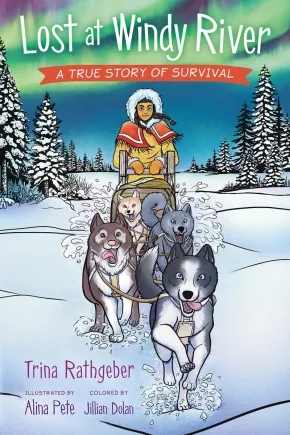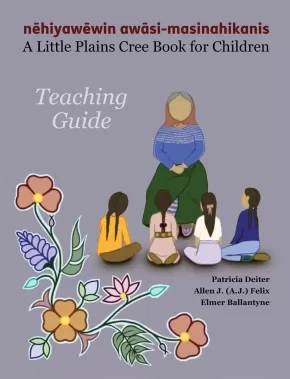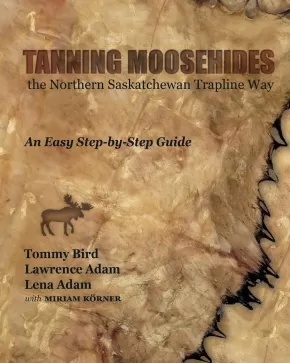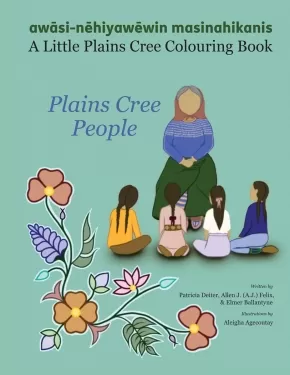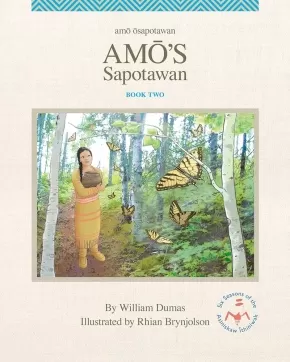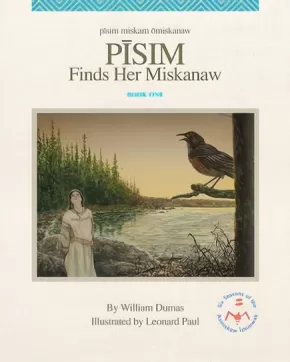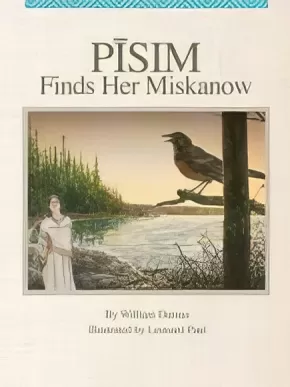
Rocky Cree
1
-
10
of
10 Results;
Sort By
Between the Pipes
$21.95
Artists:
Format:
Paperback
Text Content Territories:
Indigenous Canadian; First Nations; Cree (Nehiyawak);
ISBN / Barcode: 9781774921043
Synopsis:
Synopsis:
In this engrossing graphic novel, teen hockey player Chase learns more about himself and his identity in the face of prejudice and homophobia.
Thirteen-year-old Chase’s life and identity should be simple. He’s the goalie for his hockey team, the Eagles. He’s a friend to Kevin and Jade. He's Kookum's youngest grandchild. He’s a boy. He should like girls.
But it’s not that simple. Chase doesn’t like girls the way that the other boys do. It’s scary being so different from his peers. Scarier still is the feeling that his teammates can tell who he is—and that they hate him for it. If he pretends hard enough, maybe he can hide the truth.
Real strength and change can’t come from a place of shame. Chase’s dreams are troubled by visions of a bear spirit, and the more he tries to hide, the more everything falls apart. With the help of an Elder, and a Two-Spirit mentor, can Chase find the strength to be proud of who he is?
Between the Pipes explores toxic masculinity in hockey through the experiences of an Indigenous teen.
Reviews
“Highlights the importance of community and cultural connection as roots for embracing one’s identity.” — Kirkus Reviews
“The authors deftly confront multiple layers of intolerance exacerbated by toxic masculinity. Ojibwe artist RL uses saturated full color (with well-placed, empowering rainbows) to capture Chase’s self-empowering journey. The result is a compelling, hope-giving antidote against potential at-risk suicide among 2-Spirit/Indigenous LGBTQQIA+ youth.” — Booklist
“This hopeful...story offers valuable insight into Chase’s experience as a gay, Indigenous teen. Hockey and identity collide in this affirming graphic novel about recognizing and valuing one’s authentic self.” — School Library Journal
Educator Information
Recommended for ages 12 - 18.
Reading Level: Fountas & Pinnell Y
Additional Information
56 pages | 6.50" x 10.00" | Paperback
Lost at Windy River: A True Story of Survival
$19.95
Format:
Paperback
Text Content Territories:
Indigenous Canadian; First Nations; Cree (Nehiyawak); Woodland Cree; Rocky Cree; Peter Ballantyne Cree Nation;
ISBN / Barcode: 9781459832268
Synopsis:
Synopsis:
Iskwew Pithasew nitisithikason. My name is Lady of the Thunderbird, and this is my story.
It takes courage and bravery to survive in the barrens.
In 1944, thirteen-year-old Ilse Schweder got lost in a snowstorm while checking her family's trapline in northern Canada. This is the harrowing story of how a young Indigenous girl defies the odds and endures nine days alone in the unforgiving barrens. Ilse faces many challenges, including freezing temperatures, wild animals, snow blindness and frostbite. With no food or supplies, she relies on Traditional Indigenous Knowledge passed down from her family. Ilse uses her connection to the land and animals, wilderness skills and resilience to find her way home.
This powerful tale of survival is written by Ilse Schweder's granddaughter.
Reviews
“Colorful illustrations in classic comic-book style help readers explore the challenging landscape. An excellent choice for a book report and good addition to a children’s nonfiction collection.”- School Library Journal (SLJ), starred review
Educator Information
Recommended for ages 9 to 12.
Fountas & Pinnell Text Level Gradient: T
Lexile measure: GN700L
Guided Reading Level: T
Additional Information
96 pages | 6.00" x 9.00" | Paperback
nēhiyawēwin awāsi-masinahikanis: A Little Plains Cree Book for Children—Teaching Guide
$74.95
Format:
Coil Bound
Text Content Territories:
Indigenous Canadian; First Nations; Cree (Nehiyawak); Plains Cree;
Reading Level: N/A
ISBN / Barcode: 9781778690273
Synopsis:
Synopsis:
A Little Plains Cree Book for Children—Teaching Guide contains lesson plans, student assignments, and other helpful information for teaching the Plains Cree language—a companion to nēhiyawēwin awāsimasinahikanis: A Little Plains Cree Book for Children: A Reference for Teaching the Plains Cree Language, the content of which focuses on terms familiar to the First Nations Cree people of Saskatchewan and follows curriculum for Kindergarten to Grade 12.
Educator Information
Find the companion resource here: A Little Plains Cree Book for Children: A Reference for Teaching the Plains Cree Language
A colouring book companion is here: A Little Plains Cree Colouring Book: Plains Cree People
Additional Information
128 pages | 8.50" x 11.00" | Spiral Bound
Tanning Moosehides: The Northern Saskatchewan Trapline Way
$49.95
Format:
Coil Bound
Text Content Territories:
Indigenous Canadian; First Nations; Dene; Denesuline (Chipewyan); Fond du Lac Denes??iné First Nation; Cree (Nehiyawak); Woodland Cree; Rocky Cree; Peter Ballantyne Cree Nation;
ISBN / Barcode: 97817786903
Synopsis:
Synopsis:
Denesųłiné Elders Lawrence and Lena Adam have been tanning hides and sharing their knowledge with others for more than four decades. Woodland Cree knowledge carrier Tommy Bird helped his family tan hides on the trapline as a young boy. Together they share their lifetime of experience to guide a new generation of hide tanners to keep the tradition alive. The trouble-shooting tips and hands-on advice in this book will help you to make your own bone tools and turn raw moosehides into smoke-tanned hides soft enough to sew into mitts or moccasins. Combining traditional knowledge with easy-to-follow instructions and detailed colour photos, Tanning Moosehides the Northern Saskatchewan Trapline Way is a practical guide you will refer to again and again.
Educator Information
The publisher recommends this resource for ages 10+
Recommended in the Indigenous Books for Schools catalogue as a valuable resource for Art, Science, and Social Studies in grades 5 to 12.
Themes: Animals, Arts and Culture, Cultural Teachings, Fashion, Traditional Knowledge.
Additional Information
64 pages | 8.50" x 11.00" | Spiral Bound
A Little Plains Cree Colouring Book: Plains Cree People
$24.95
Format:
Paperback
Text Content Territories:
Indigenous Canadian; First Nations; Cree (Nehiyawak); Plains Cree;
ISBN / Barcode: 9781778690136
Synopsis:
Synopsis:
A colouring book that teaches the Plains Cree language! A Little Plains Cree Colouring Book—Plains Cree People explores kinship relationships, the names of various family members and careers in the Plains Cree language.
The content focuses on terms familiar to the First Nations Cree people of Saskatchewan and is a companion to nēhiyawēwin awāsi-masinahikanis—A Little Plains Cree Book for Children: A Reference for Teaching the Plains Cree Language. Our hope is to encourage a basic understanding of the language so that learners are able to converse with Plains Cree speakers. The best path to fluency in the Plains Cree language is immersion, but learning one word at a time is a good place to start!
Educator Information
Recommended for ages 3 to 12.
Find companion resources here:
- A Little Plains Cree Book for Children: A Reference for Teaching the Plains Cree Language
- nēhiyawēwin awāsi-masinahikanis: A Little Plains Cree Book for Children—Teaching Guide
Additional Information
56 pages | 8.50" x 11.00" | Paperback
A Little Plains Cree Book for Children: A Reference for Teaching the Plains Cree Language
$74.95
Format:
Paperback
Text Content Territories:
Indigenous Canadian; First Nations; Cree (Nehiyawak); Plains Cree;
ISBN / Barcode: 9781778690044
Synopsis:
Synopsis:
A Little Plains Cree Book for Children contains useful noun categories, phrases, and some basic rules for the Plains Cree language. Following the themes of the Saskatchewan Curriculum Guide for Kindergarten to Grade 12 on Aboriginal Languages, the content focuses on terms familiar to the First Nations Cree people of Saskatchewan. This book should also be supplemented by total physical response (TPR) methods, in addition to teaching materials such as songs, games, and flash cards. Our hope is to encourage a basic understanding of the language so that learners are able to converse with Plains Cree speakers. The best path to fluency in the Plains Cree language is immersion, but learning one word at a time is a good place to start!
Educator Information
Recommended for ages 5+
A teaching guide can be found here: nēhiyawēwin awāsi-masinahikanis: A Little Plains Cree Book for Children—Teaching Guide
Find a colouring book here: A Little Plains Cree Colouring Book: Plains Cree People
Additional Information
96 pages | 8.50" x 11.00" | Paperback
Amo's Sapotawan
$33.00
Artists:
Format:
Hardcover
Text Content Territories:
Indigenous Canadian; First Nations; Cree (Nehiyawak); Woodland Cree; Rocky Cree;
ISBN / Barcode: 9781553799290
Synopsis:
Synopsis:
A Rocky Cree girl must choose the skill that will define her miskanaw, the path of her life, in the second book of The Six Seasons of the Asiniskaw Īthiniwak series.
Rocky Cree people understand that all children are born with four gifts or talents. When a child is old enough, they decide which gift, or mīthikowisiwin, they will seek to master. With her sapotawan ceremony fast approaching, Amō must choose her mīthikowisiwin. Her sister, Pīsim, became a midwife; others gather medicines or harvest fish. But none of those feel quite right.
Amō has always loved making things. Her uncle can show her how to make nipisiwata, willow baskets. Her grandmother can teach her how to make kwakwāywata, birchbark containers and plates. Her auntie has offered to begin Amō’s apprenticeship in making askihkwak, pottery.
What will Amō’s mīthikowisiwin be? Which skill should she choose? And how will she know what is right for her?
Educator & Series Information
Recommended for ages 9 to 11.
This is the second book in The Six Seasons of the Asiniskaw Īthiniwak series.
Reading Level: Fountas & Pinnell X
Includes some Cree language.
Additional Information
60 pages | 10.00" x 12.00" | Hardcover
The Gift of the Little People: A Six Seasons of the Asiniskaw Īthiniwak Story
$22.95
Artists:
Format:
Hardcover
Text Content Territories:
Indigenous Canadian; First Nations; Cree (Nehiyawak); Woodland Cree; Rocky Cree;
ISBN / Barcode: 9781553799924
Synopsis:
Synopsis:
Helpless to stop the spread of a deadly sickness, Rocky Cree Elder Kākakiw must travel to the home of the Little People to find a cure before it’s too late.
I don’t recall seeing books when I was a little boy. But the old people, they grew up listening to stories. And so, every night, when the old people were done their evening prayers, they would sit and they would tell us stories too.
At the time of the spring thaw, the Rocky Cree fill their canoes with furs, eager to trade with the new visitors in mistiwāsahak (Hudson Bay). But not all of the new visitors are welcome.
When the canoes return home to the shores of the misinipī river, the Rocky Cree begin to collapse one by one, drenched in sweat and slowly slipping into delirium. Kākakiw struggles to help the sick as more and more people pass into the spirit world. Exhausted physically, emotionally, and spiritually, he seeks guidance through prayer.
Hope finally comes with a visitor in the night: one of the Little People, small beings who are just like us. If Kākakiw can journey to their home, he will be given the medicine his people need. All he has to do is paddle through a cliff of solid bedrock to get there.
To save his people from certain death, Kākakiw must overcome doubt to follow the traditional teachings of the Asiniskaw Īthiniwak and trust in the gift of the Little People.
In this illustrated short story for all ages, celebrated Rocky Cree storyteller William Dumas shares a teaching about hope in the face of adversity. This book is a companion story to The Six Seasons of the Asiniskaw Īthiniwak series.
Reviews
"A tale rich with warmth and wonder that not only documents traditions but carries them on." — David A. Robertson, author The Barren Grounds
Educator & Series Information
Recommended for ages 9 to 11.
Reading Level: Lexile® Framework for Reading: 870L
This book is a companion story to The Six Seasons of the Asiniskaw Īthiniwak series. This series is about the Asiniskaw Īthiniwak (Rocky Cree) of Northern Manitoba. Corresponding to the six seasons of sīkwan (spring), nīpin (summer), takwakin (fall), mikiskow (freeze-up), pipon (winter), and mithoskamin (break-up), the books explore the language, culture, knowledge, territory, and history of the 17th century Rocky Cree people through story and images. The groundbreaking series centres Indigenous ways of knowing and includes insights from a wide range of disciplines—cross-cultural education, history, archaeology, anthropology, linguistics, literature, oral culture and storytelling, experiential and community-based learning, and art.
Contains some Cree language/words, and a glossary of them.
Additional Information
48 pages | 6.00" x 9.00" | Hardcover
Pisim Finds Her Miskanaw: Revised
$29.00
Artists:
Format:
Hardcover
Text Content Territories:
Indigenous Canadian; First Nations; Cree (Nehiyawak); Woodland Cree; Rocky Cree;
ISBN / Barcode: 9781553799092
Synopsis:
Synopsis:
NOW REVISED! This edition features updated Rocky Cree translations and an expanded glossary, augmented with new maps to give a more detailed look at Pīsim’s journey. These enhancements make this book a great tool for teachers and a great addition to any library.
Out of an important archaeological discovery came this unique story about a week in the life of Pīsim, a young Cree woman, who lived in the mid 1600s. In the story, created by renowned storyteller William Dumas, Pīsim begins to recognize her miskanaw – the path for her life – and to develop her gifts for fulfilling that path. The story is brought to life by the rich imagery of Mi’kmaw artist Leonard Paul, and is accompanied by sidebars on Cree language and culture, archaeology and history, maps, songs, and more.
Reviews
"In imagining the life of a young Cree woman, this volume provides a wonderful evocation of the wisdom and language of Cree elders that seamlessly incorporates archaeology, ethnology, and oral traditions." — Stephen Loring, Arctic Studies Center, Smithsonian Institute, Washington DC
"This rich story ... brings alive the history and language of Asiniskow Ithiniwak in Manitowapow while illustrating the cultural breadth of a dynamic community. This book is a joy to read, teach, and share with my daughter." — Niigaanwewidam James Sinclair, Assistant Professor, Dept. of Native Studies University of Manitoba
"The brilliant teamwork between archaeologists, the Cree, and an accomplished storyteller gives us... a beautifully written and illustrated journey into a centuries-old world... the books promises to be a classic of Canadian history." — Brian Fagan, Emeritus Professor of Anthropology, University of California, Santa Barbara, and author of The First North Americans
Educator & Series Information
Pīsim Finds Her Miskanaw is book one in The Six Seasons of the Asiniskow Īthiniwak series about the Asiniskow Īthiniwak (Rocky Cree) of Northern Manitoba. Corresponding to the six seasons of sīkwan (spring), nīpin (summer), takwakin (fall), mikiskow (freeze-up), pipon (winter), and mithoskamin (break-up), the books explore the language, culture, knowledge, territory, and history of the 17th century Rocky Cree people through story and images. The groundbreaking series centres Indigenous ways of knowing and includes insights from a wide range of disciplines – cross-cultural education, history, archaeology, anthropology, linguistics, literature, oral culture and storytelling, experiential and community-based learning, and art.
Recommended for ages 9 to 12.
Reading Level: Lexile® Framework for Reading: 940L
Contains some Cree language.
Additional Information
60 pages | 10.00" x 12.00" | Revised | Hardcover
Pīsim Finds Her Miskanow (7 in Stock) - ON SALE
$24.00 $29.00
Artists:
Format:
Hardcover
Text Content Territories:
Indigenous Canadian; First Nations; Cree (Nehiyawak);
ISBN / Barcode: 9781553793946
Synopsis:
Synopsis:
Pīsim Finds Her Miskanow is about a week in the life of Pīsim, a young Cree woman living in the late 1600s. The 1993 archaeological excavation of the remains of a woman and her belongings from Nagami Bay at South Indian Lake, Manitoba, was the inspiration for the story. In the story, Pīsim begins to both recognize her purpose for being and develop her gifts for fulfilling her purpose. This beautifully illustrated book includes drawings of artifacts, definitions and descriptions, historical facts and information, Cree songs and words, maps, recipes, and much more.
Sort By




